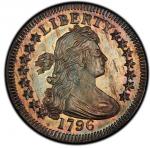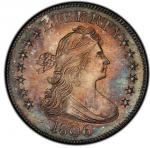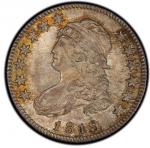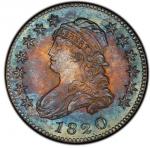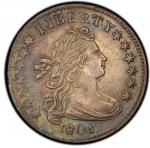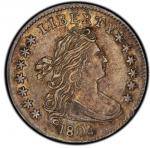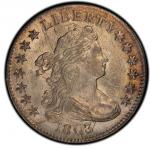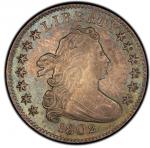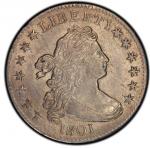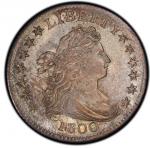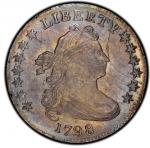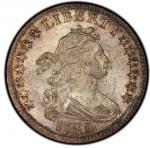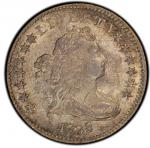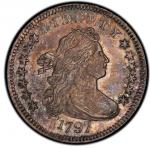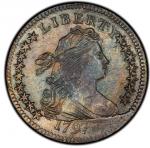If a collector were asked to name the four rarest American silver coins, he would, I am sure, naming them in the order of their denominations, say: the 1804 dollar, 1823 quarter, 1827 quarter, and 1802 half dime. — Harold P. Newlin, 1883A beautiful example of this classic key date rarity, the D. Brent Pogue Collection specimen is enriched by superlative toning and an august provenance. Abundant reflective character remains, strongest at the peripheries and around devices, copresent with more subtle cartwheel luster. The peripheral toning is mostly bright blue and violet, the centers a pleasing maize-tinted gold. The strike is superb, with most star centers present, central devices well-defined, and the overdate readily seen. Small areas of weakness, as seen on other high grade specimens, include the talons and UR of PLURIBUS on the reverse scroll. Light handling is seen, but precious little actual wear, and the difference between this coin and a lower-end Mint State piece is ephemeral. A thin hairline in the right obverse field blends in beneath star 11. A shallow vertical scratch in the same vicinity and some other light lines are detected with concerted effort. Perhaps the second finest business strike, though in some connoisseurs eyes it remains the prettiest.The rarity of this date was already legendary by the time Montroville W. Dickeson wrote his 1859 American Numismatical Manual, where he pronounced this date extremely rare. Dickeson and his contemporaries did not understand that reported mintage figures may have reflected the year the coins were delivered, but not necessarily the dates on the dies that were used to make them. His Manual gave a mintage figure of 17,800 coins, which encompasses all coins delivered in the 1823 calendar year. Today, considering the rarity of this date, most scholars presume that almost the entire delivered mintage of 1823 was actually dated 1822. By most estimates, just 35 specimens of this rarity exist over the whole continuum of possible states of preservation, most quite worn, a few damaged, even one famously repaired to remove graffiti. As cited above, in 1883, Harold P. Newlin posited that the four rarest U.S. silver coins were the 1802 half dime, the quarters of 1823 (all of which are 1823/2) and 1827, and the 1804 dollar. The Pogue Collection has exceptional specimens of all of these. Few American rarities have been so lovingly documented as the 1823/2 quarter, so carefully studied for provenance and technical nuance, and so appreciatively collected by those able to purchase one.Thirty-one discrete specimens have been documented, and a few more are assumed to exist in old-time collections or unexamined institutional holdings, yielding about 35. The Smithsonian Institution and the Durham Western Heritage Museum in Omaha both own well worn specimens. A single Proof exists. More than half of the known survivors are in grades below Very Fine; just five are better than Extremely Fine.This choice example is one of the best survivors, with a provenance that can be reliably traced back to the Anderson-Dupont sale of 1954, later through the famed collections of Mrs. Emery May Norweb, Charlton Swampy Meyer, and D. Brent Pogue. Some writers have suggested this was the 1823/2 quarter in Wayte Raymonds (as J.C. Morgenthau & Co.) 1940 sale of the William Hunt Collection and 1933 sale of the Henry Sternberg Collection, two appearances of the same coin described as Uncirculated except for the slightest abrasion, a scratch about one quarter inch in length in obverse field before face. For the usually terse Raymond to point out the flaw, it must have been fairly dramatic. The coin was unplated, and none of the coins that approach Mint State grade today show such a scratch, leaving a few explanations. The most unlikely is that there is a high grade 1823/2 quarter that disappeared in 1940 and has not been spoken of since. More likely options include the fact that the unplated coin, which sold for $400 despite Raymond recording that nearly $1,000 had been paid for it, was not a genuine 1823/2 but instead had an altered date; Sternberg purchased the coin from a dealer in Denmark, and he may have fallen victim of the ancient practice of unethical American dealers laundering counterfeit or altered coins through European dealers to make them appear to be new discoveries. Perhaps the likeliest scenario of all is that the coin was as described in 1933 and 1940, but since then has had the large scratch removed and has blended into the ranks of VF-EF specimens since its repair. Whatever the truth is, there is no doubt the Norweb coin, long hidden from view in the collection thats come to be known as the Anderson-Dupont Collection, was not the piece offered in 1933 and 1940.The John G. Mills (1904) coin was fair, while Cleneays (1890) was good for date, worn as is usual. The great James Ten Eyck settled for the plugged one Charles Steigerwalt sold him in 1887 and never upgraded it before his death in 1910. Of course, he didnt have much of a chance, as many of the great sales in that interval, including David S. Wilson, Stickney, James B. Wilson, and Gschwend, didnt have any 1823/2 quarters at all. In the two years after Ten Eycks death, the world-class selection of quarters in the Mougey and Earle collections also lacked this date, like nearly every run of quarters before or since, skipping from 1822 to 1824, with a monument-sized gap in the middle. H.O. Granberg was so proud of his that he brought it to display at the famous exhibition of rarities staged by the American Numismatic Society in 1914, along with his 1794 dollar, a Mint State 1795 dollar, an extremely rare 1870-S dollar, and his 1827 quarter. The Granberg coin, untraced in recent decades, is EF and listed as eighth finest known.The present example is acclaimed as second finest known among the circulation strikes, though a single Proof is known. This coin is nearly tied atop the census with the H.P. Smith (1906) - Gene Gardner (2014) coin, once graded MS-61 by NGC but recently certified by PCGS as AU-58+. PCGS has never certified a Mint State example.If this auction were being held in another dimension, surely Lorin G. Parmelee, T. Harrison Garrett, James Ten Eyck, F.C.C. Boyd, and others would compete for the chance to acquire this coin and upgrade their fine cabinets. As only bids from living collectors will be accepted, collectors of the present generation who have always wanted to own a superb specimen of this rarity have an exceptionally scarce opportunity to acquire not just a nice 1823/2 quarter, but one of the very best.

